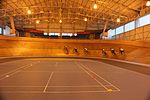Calshot Lifeboat Station
Calshot Lifeboat StationLifeboat stations in HampshireUse British English from February 2017

Calshot Lifeboat Station is located on Calshot Spit near the village of Calshot, Hampshire, and is on the southern bank of the open end of Southampton Water, on the south coast of England. The station is owned and operated by the Royal National Lifeboat Institution (RNLI) and operates two inshore lifeboats: an Atlantic 85 called Max Walls (B-860) and a D-class (IB1) called RNLB David Radcliffe (D-880).
Excerpt from the Wikipedia article Calshot Lifeboat Station (License: CC BY-SA 3.0, Authors, Images).Calshot Lifeboat Station
Jack Maynard Road, New Forest Fawley
Geographical coordinates (GPS) Address Website External links Nearby Places Show on map
Geographical coordinates (GPS)
| Latitude | Longitude |
|---|---|
| N 50.820222222222 ° | E -1.3083611111111 ° |
Address
Calshot Lifeboat Station
Jack Maynard Road
SO45 1BR New Forest, Fawley
England, United Kingdom
Open on Google Maps









